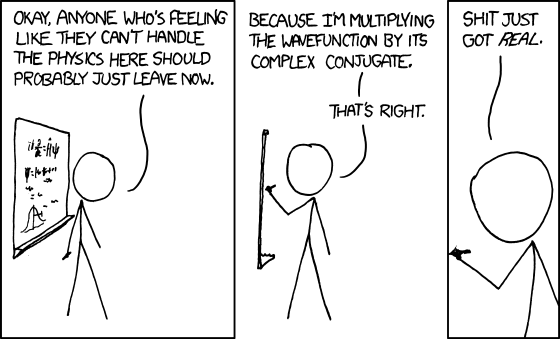Getting real
« previous post | next post »
The latest xkcd:

The mouseover title: "Fun fact: if you say this every time a professor does something to a complex-number equation that drops the imaginary part, they'll eventually move the class to another room and tell everyone else except you."
I plan to get ahead of the game by putting this strip into my lecture notes on the Discrete Fourier Transform.
My favorite instance of this pun is S. F. Gull, A. N. Lasenby and C. J. L. Doran, "Imaginary Numbers are not Real – the Geometric Algebra of Spacetime", Found. Phys. 23(9), 1175-1201 (1993), which explores "the claim that complex numbers arising in physical applications usually have a natural geometric interpretation that is hidden in conventional formulations". A linguistic bonus is the fact that the proposed way of multiplying vectors traces back to the work of Herman Grassmann, the discoverer of Grassmann's Law (of aspiration dissimilation in Greek and Sanskrit).
[For those whose algebra may be a bit rusty, recall that a complex number has the general form a + bi, where i is √–1 and a and b are arbitrary real constants. The complex conjugate of a + bi is a – bi, and obviously (a + bi)(a – bi) = a2 + b2, in which the imaginary parts of the expression cancel out.]
Rubrick said,
January 20, 2011 @ 6:27 pm
I plan to get ahead of the game by putting this strip into my lecture notes on the Discrete Fourier Transform.
Joining, no doubt, this classic?
Ralph Hickok said,
January 20, 2011 @ 7:38 pm
Shouldn't that be a2 – b2?
[(amz) No. (a + bi)(a – bi) = a2 – (bi)2 = a2 – (b2)(i2) = a2 + b2 (since i2 = –1).]
Brian said,
January 20, 2011 @ 8:39 pm
And don't forget the classic: "Life is complex: it has both real parts and imaginary parts."
J Lee said,
January 20, 2011 @ 8:47 pm
Worst. Post. Ever.
Yuji said,
January 20, 2011 @ 9:45 pm
There are many other notable math articles which use this pun. E.g. Sir Michael Atiyah's "K-theory and reality" is a classic: http://qjmath.oxfordjournals.org/content/17/1/367
Of course K-theory has nothing to do with "reality" …
Bill Poser said,
January 20, 2011 @ 9:46 pm
This reminds me of the joke about the value of the contour integral around Western Europe, which is zero, since there are no Poles. Actually, there are some Poles in Western Europe, but they are removable.
Nathan Myers said,
January 20, 2011 @ 10:26 pm
I'm only half hoping J Lee's comment is not taken as a challenge.
Mark P said,
January 20, 2011 @ 10:26 pm
Nerd humor.
It reminds me of the quote I see attributed to various scientists: "We have not succeeded in answering all our problems. The answers we have found only serve to raise a whole set of new questions. In some ways we feel we are as confused as ever, but we believe we are confused on a higher level and about more important things."
In this case, we are amused on a higher level.
Ole Phat Stu said,
January 21, 2011 @ 1:11 am
I wrote this Complex Number Tutorial several years ago and it still gets lots of daily hits, even from .edu domains (see http://home.egge.net/~savory/maths20.htm) :-)
Troy S. said,
January 21, 2011 @ 4:46 pm
Reminds me of an urban legend that the MIT telephone switchboard once had a special message when somebody called a number that didn't exist: "I'm sorry. The number you have dialed is imaginary. Please rotate your telephone 90 degrees and try again."
Jerry Friedman said,
January 25, 2011 @ 6:45 pm
So why is it that at a language blog I find other people who understand why I LedOL at that xkcd? Not to mention the one on pumpkin carving.